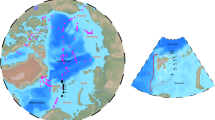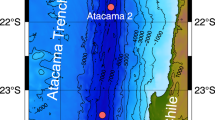Abstract
The legacy and reach of anthropogenic influence is most clearly evidenced by its impact on the most remote and inaccessible habitats on Earth. Here we identify extraordinary levels of persistent organic pollutants in the endemic amphipod fauna from two of the deepest ocean trenches (>10,000 metres). Contaminant levels were considerably higher than documented for nearby regions of heavy industrialization, indicating bioaccumulation of anthropogenic contamination and inferring that these pollutants are pervasive across the world’s oceans and to full ocean depth.
This is a preview of subscription content, access via your institution
Access options
Access Nature and 54 other Nature Portfolio journals
Get Nature+, our best-value online-access subscription
$29.99 / 30 days
cancel any time
Subscribe to this journal
Receive 12 digital issues and online access to articles
$119.00 per year
only $9.92 per issue
Buy this article
- Purchase on Springer Link
- Instant access to full article PDF
Prices may be subject to local taxes which are calculated during checkout


Similar content being viewed by others
References
Ramirez-Llodra, E. et al. PLoS ONE 6, p.e22588 (2011).
Smith, K. L. et al. Proc. Natl Acad. Sci. USA 46, 19211–19218 (2009).
Scheringer, M. et al. Environ. Sci. Pollut. R. 11, 41–48 (2004).
Jamieson, A. J. et al. Trends Ecol. Evol. 25, 190–197 (2010).
Rhind, S. M. Acta Vet. Scand. 54, S2 (2012).
Ballschmiter, K. et al. Fresen. Z. Anal. Chem . 316, 242–246 (1983).
Allchin, C. R., Law, R. J. & Morris, S. Environ. Pollut. 105, 197–207 (1999).
Breivik, K. et al. Sci. Tot. Environ. 377, 296–307 (2007).
Tanabe, S. Environ. Pollut. 50, 5–28 (1988).
Martin, M., Lam, P. K. & Richardson, B. J. Mar. Pollut. Bull. 49, 375–382 (2004).
Knezovich, J. P., Harrison, F. L. & Wilhelm, R. G. Water Air Soil Poll. 32, 233–245 (1987).
Froescheis, O. et al. Chemosphere 40, 651–660 (2000).
Jamieson, A.J. in Biological Sampling in the Deep Sea (eds Clarke, M. & Consalvey, M. ) 228–259 (Wiley-Blackwell, 2016).
ICES Report of the ICES Advisory Committee on Marine Pollution (Cooperative Research Rep. 135, International Council for Exploration of the Sea, 1986).
Phillips, D. J. H. in PCBs and the Environment Vol. II (ed. Waid, J. S. ) 127–181 (CRC Press, 1986).
Denton, G. R. et al. Water and Environmental Research Institute of the Western Pacific (WERI) Technical Report 87 (1997).
Nie, X. et al. Mar. Pollut. Bull. 50, 537–546 (2005).
Teng, M. et al. Chinese Sci. Bull. 58, 1751–1759 (2013).
Lee, J. S. et al. Mar. Pollut. Bull. 34, 250–258 (1997).
Takahashi, S. et al. Sci. Tot. Environ. 214, 49–64 (1998).
Stewart, M. et al. Sci. Tot. Environ. 468, 202–210 (2014).
Felker, G. B. Third World Q. 24, 255–282 (2003).
Kaiser, J. Science 328, 1506–1509 ( 2010).
Oguri, K. et al. Sci. Rep. 3, 1915 (2013).
Linley, T. D. et al. Deep-Sea Res. I 114, 99–110 (2016).
Rhind S. M. et al. J. Environ. Monit. 12, 1582–1593 (2010).
Axelsson, M. & Gentili, F. PLoS ONE 9, e89643 (2014).
Acknowledgements
The Kermadec and Mariana ‘HADES’ expeditions (RV Thomas G. Thompson TN309, and RV Falkor FK141109) were funded through the National Science Foundation (NSF-OCE nos 1130712 and 1140494) and the Schmidt Ocean Institute. S.B.P. was supported by a Fellowship from the Leverhulme Trust. The analytical costs were supported by the Total Foundation (France) and the Marine Alliance for Science and Technology, Scotland (MASTS) through a Deep Sea Forum small grant award.
Author information
Authors and Affiliations
Contributions
A.J.J. conceived the experiment, designed the sampling equipment and was awarded the analytical costs. A.J.J. and S.B.P. performed the sampling at sea. S.B.P identified species, and T.M. performed the laboratory analysis under the supervision of Z.Z. and A.J.J., T.M. and T.F. performed the statistical analyses and the manuscript was written by A.J.J., T.M., S.B.P. and Z.Z.
Corresponding author
Ethics declarations
Competing interests
The authors declare no competing interests.
Supplementary information
Supplementary information
Supplementary Tables 1–4 (PDF 145 kb)
Rights and permissions
About this article
Cite this article
Jamieson, A., Malkocs, T., Piertney, S. et al. Bioaccumulation of persistent organic pollutants in the deepest ocean fauna. Nat Ecol Evol 1, 0051 (2017). https://doi.org/10.1038/s41559-016-0051
Received:
Accepted:
Published:
DOI: https://doi.org/10.1038/s41559-016-0051
This article is cited by
-
Global prevalence of organohalide-respiring bacteria dechlorinating polychlorinated biphenyls in sewage sludge
Microbiome (2024)
-
Marine pollution and ecological degradation—issues and challenges
Environmental Science and Pollution Research (2024)
-
Organic matter degradation causes enrichment of organic pollutants in hadal sediments
Nature Communications (2023)
-
First insight into accumulation of characteristics and tissue distribution of PCBs, PBDEs, and other BFRs in the living Indonesian coelacanth (Latimeria menadoensis)
Environmental Science and Pollution Research (2023)
-
Novel Chloroflexi genomes from the deepest ocean reveal metabolic strategies for the adaptation to deep-sea habitats
Microbiome (2022)



